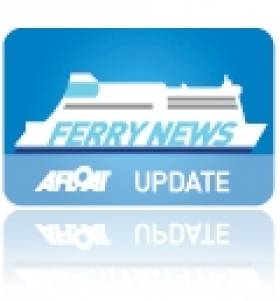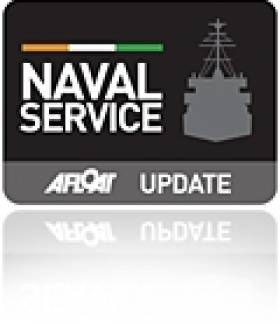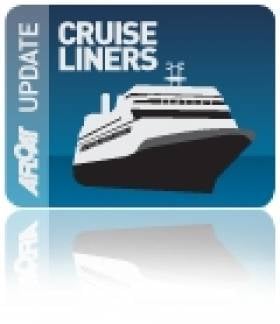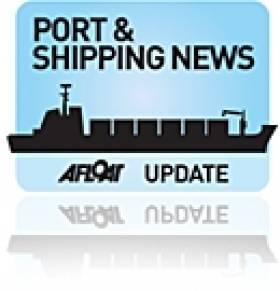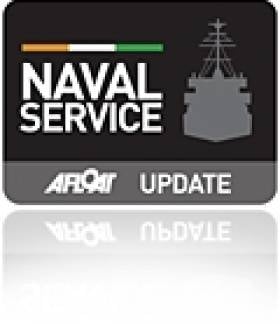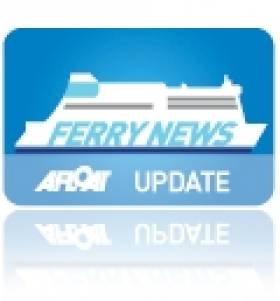Displaying items by tag: Ports and Shipping News
The 162 gross tonnes tug had served a career of nearly three decades in Dublin Port, after entering service in 1972. Prior to working in Irish waters the 100ft tug spent the previous decade operating in the UK as Appelsider for Lawson-Batey Tugs Ltd who chartered her to Tyne Tugs Ltd. For historical record and photos click HERE.
In 1998 the Dublin Port Company disposed of the Coliemore alongside her running mate Clontarf (1963/178grt) the former Cluain Tarbh, also built from the same Yorkshire shipyard on the banks of the River Humber.
Initially they were towed to Liverpool but they later appeared at Cork Dockyard in 1999. The Clontarf remained there for a year until she was sold to Barcazas Dominicia SA, Santo Domingo in the Dominican Republic. For photo of the tug in far distant waters click HERE. It was intended Coliemore would follow her Caribbean counterpart but her sale fell-through.
The vessel's ownership eventually transferred to Cork Dockyard where her scrap value will pay for her long-term berthing fees. The tug recently made her final short journey under tow from her berth at the former Verolme Cork Dockyard (VCD) to the facilities slipway where work to break-up the vessel began.
Coliemore and her fleet-mates were given the traditional naming theme of Dublin Bay coastal suburbs spelt in Irish. The naming policy was used by the Dublin Ports & Docks Board (DP&DB) which operated the fleet remained until transferred to the Dublin Port Company established in 1997.
The last tugs to carry the traditional names, Ben Eadar (Howth), Cluain Tarbh (Clontarf) and Deilginis (Dalkey) are now up laid-up awaiting to be sold, to read more click HERE.
Between the 14-16th centuries Dalkey Sound became increasingly important as larger vessels with deeper drafts could no longer enter the port in Dublin due to the dangers of constantly shifting sandbanks and swallow channels in Dublin Bay.
The nearest alternative was for vessels to anchor off Dalkey Island and in the relative shelter of Dalkey Sound where cargoes for the capital where transferred to and fro by lighters to the coastline along Dalkey at Coliemore, which became the principle port for Dublin. Some of the cargo was stored temporally in the medieval castles in Dalkey, otherwise it was directly transported by horse and cart across the plateau to the city.
It was not until the 17th century that the issue of accessing the port of Dublin was resolved, with the completion of the harbour walls that enabled shipping to return on a frequent basis. Captain Bligh of the 'Mutiny on the Bounty' completed mapping Dublin Bay in 1803 which became the most accurate chart at the time and this aided to the safety of mariners.
The fortunes of Dublin's shipping trade increased due to the combination of an easier and safer navigational channel and deeper depths along the quaysides. This led to the eventual demise of shipping using Dalkey. The present-day harbour structure at Coliemore Harbour was constructed in 1868 and is home to a humble fleet of recreational boats and a passenger-ferry service to the island.
- Howth
- Dublin Bay
- Dublin Port
- Clontarf
- Dublin Port Company
- dalkey
- coliemore harbour
- Dalkey Island
- Port of Dublin
- Ports and Shipping News
- Cork Harbour News
- Verolme Cork Dockyard
- VCD
- Dalkey Sound
- Mutiny on the Bounty
- Dublin Port Tugs
- Deilginis
- Captain Bligh
- Dublin port tugs for sale
- Coliemore
- Coliemore tug
- Cork Dockyard
- Cork Dockyard Rushbrooke
- Cluain Tarbh tug
- Ben Eadar tug
- Deilginis tug
- Richard Dunston (Hessle) Yorkshire
- River Humber
- Dublin Ports & Docks Board
- DP & DB
- Cork Dockyard shiprepairers
- Irish shipbuilding
Rosslare Europort to Host Irish Ports Conference
This year's Irish Ports Conference is to be hosted by Rosslare Europort on behalf of the Irish Port Association (IPA) and is to take place in Wexford on 30th September.
The event is the only one of its kind in Ireland this year where senior representatives from short-sea users, carriers, ports, logistics providers and the whole range of service providers meet to debate the topical issues of the day.
In addition the full-day conference provides those to network and explore further business opportunities and will culminate with the IPA's conference banquet.
The south-eastern ferry-port is to host delegates in the Ferrycarrig Hotel, just outside Wexford. For further information on booking and a (PDF) programme of the day visit the Rosslare Europort website by clicking HERE
LE Roisin On Goodwill Visit to Tallinn
Three Masterpieces Set to Make an Impression in Dublin
Arcadia caters for the UK market and she is on a 13-night cruise which so far has included calls to North Shields, Tyneside, Invergordon, Shetland Isles, Glasgow, Belfast and Liverpool. After her call to the capital she heads for Cork and finally to St Peter Port, Guernsey.
Readers may note that the vessel is of the same design as of Cunard Line's Queen Victoria, which also called to Dublin in May and Cork. In fact Arcadia was to be given the regal name but the 2005 Italian built vessel was transferred from Cunard Line to P&O Cruises, which are under control of US-owned cruise giant Carnival Corporation.
Notable external features of the Arcadia are glass-fronted lifts, two pools, one with a skydome and an interior that is brimming with an art collection consisting of over 3,000 works. She has many facilities such as a three-tier palladium theatre, an intimate 30-seater cinema and gymnasium with an ocean view to inspire those exercising at sea. She was constructed in just twenty months by the Fincantieri shipyard, just outside Venice.
Likewise Eurodam has an extensive art collection theme that is based on the Dutch master's 'Golden Age' including "The Nightwatch, Two Minutes Later", a contemporary re-interpretation of Rembrandt's famous painting. In addition there are 17th-century watercolour maps by famed cartographer Johannes Vingboons.
Passengers on the 11-decked Signature-class can also enjoy the Pan-Asian restaurant and lounge surrounded by panoramic views, an explorer's lounge bar, an Italian restaurant adjacent to the lido, jewellery boutique, atrium bar, show lounge and a photographic and imaging-centre.
Last but not least to dock around lunchtime will be the 30,000 tonnes Ocean Princess, operated by Princess Cruises, another subsidiary of the Carnival Corporation. The 680-passenger / 181 m long vessel may be the smallest of tomorrow's callers and within the Princess Cruises fleet, but the former Tahitian Princess, which underwent an extensive dry-docking in Singapore last winter is well equipped with facilities.
She has a cabaret lounge, club restaurant and bar, casino bar, main pool and spa, steakhouse restaurant, panorama buffet, an Italian restaurant and the Tahitian Lounge. To see the work conducted at the dry-dock, you can view a slideshow by clicking HERE and to see the work in a completed state which also applied to her sister Pacific Princess, watch this VIDEO.
- Dublin Port
- port of Cork
- Dublin Bay News
- Princess Cruises
- P&O Cruises
- Cruiseships
- Port of Dublin
- Ports and Shipping News
- Cunard Line
- Dublin Port news
- Holland America Line
- queen victoria
- Fincantieri Shipyard
- Port of Dublin news
- Arcadia
- Eurodam
- Ocean Princess
- Irish cruiseship ports ofcall
- Dutch masters
- Rembrandt
- Onboard Art Collection
- Johannes Vingboons
Port and Shipping Volumes Show Second Quarter Slowdown
Below is a list of figures for each transport mode based for the second quarter of 2011.
•Lift-on/Lift-off (lo/lo) trades remained static at 0%.
•Roll-on/Roll-off (ro/ro) export traffic was down by 1%.
•Dry bulk volumes increased by 5%,
•Break bulk volumes were down by 6%
•The Tanker/Liquid bulk market was down 6%.
For more in-depth analysis of each freight-transport mode issued by the IMDO and accompanied by graphic charts click HERE.
Naval Service OPV On Visit to Russia and Baltic States
Since Tuesday the offshore patrol vessel (OPV) has been berthed in the Baltic city of St. Petersburg. Her naval officers laid a wreath at the Piskarevskoye Memorial Cemetery. Also visited was the Central Naval Museum and the naval cruiser Aurora, where one of the first incidents of the 'October' Russian revolution took place in 1917.
Irish Ambassador to Russia Philip McDonagh boarded the L.E. Roisin yesterday to highlight Irish-Russian bi-lateral relationships and co-operation between the two countries in areas of economic, culture, education and tourism. In the first-half of 2010 bi-lateral trade with Russia was up 66% and St. Petersburg is the most important economic centre after Moscow.
The trade mission follows last year's visit of president Mary McAleese who became the first Irish head of state to visit Russia. On her visit which included St. Petersburg, she signed a protocol on partnership and co-operation between the Russian city and Dublin during the third St. Petersburg International Innovation Forum.
In March of this year representatives from St. Petersburg took part in the Russian Culture Festival in Dublin. Three months later in July, the Irish capital was visited by the Russian Naval destroyer Admiral Chabanenko (650), the flagship of the countries Northern Fleet. For more on that visit of the Udaloy –II class destroyer click HERE.
L.E. Roisin is not the first Irish Naval Service vessel to visit the Russian Federation as this accolade goes to the flagship L.E. Eithne (P31) which called to St. Petersburg in 2003.
- Irish Naval Service
- Dublin Port
- naval service
- Ports and Shipping News
- LE Eithne
- Naval Visits
- Navy News
- Irish navy news
- L.E. Roisin
- LE Roisin
- Irish OPV vessels
- St. Petersburg trade mission
- IrishRussian trade
- Irish Ambassador to Russia
- President Maru McAleese
- Irish trade delegation to Russia
- Lt Cdr Peter Twomey
- Philip McDonagh
- Adi Roche
- Chernobyl Children's Project
Dublin Port Tug Trio For Sale
The smallest of the tugs for sale is the 17-tonnes bollard pull Ben Eadar (1972/198grt) which was built by Richard Dunston (Hessle) Ltd. She is berthed elsewhere in the port alongside the former Dundalk Port Company owned dredger Hebble Sand, which too has been recently put up for sale. For more information about the grab-hopper dredger click HERE.
Ben Eadar was decommissioned in 2009 and her 35-tonnes bollard-pull fleetmates Cluain Tarbh (1991/268grt) built by McTay Marine of Bromborough and Deilginis (1996/335grt) remained in service until late last year.
Of the trio Deilginis is the last tug commissioned by the Dublin Port & Docks Board (DP&DB) and the 30m tug is also the last to carry a traditional naming theme based on Dublin Bay coastal suburbs spelt in Irish. Deilginis is the Irish for Dalkey, Cluain Tarbh is for Clontarf and Ben Eadar is a translation for Howth.
Deilginis was launched from Astilleros Zamakona S.A. in Bilbao, the same Spanish shipyard that was commissioned by the Dublin Port Company to build two 50-tonnes bollard pull tractor tug sisters. The first newbuild Shackleton entered service late last year and she was followed by Beaufort in early 2010. In March of that year the tugs that cost €6m each to build were officially named in a joint ceremony.
- Dublin Bay
- Clontarf
- Dublin Port Company
- Dundalk Port Company
- howth
- dalkey
- Port of Dublin
- Ports and Shipping News
- Dublin Port Tugs
- Deilginis
- Cluain Tarbh
- Ben Eadar
- Dublin Port & Docks Board
- Hebble Sand
- Dredger for Sale
- VoithSchneider trator tugs
- EastLink bridge
- North Wall Extension
- Dublin Bay suburbs
- McTay Marine
- Richard Dunston (Hessle) Ltd
- Astilleros Zamakoza S.A. Bilbao
First Heysham-Max Newbuild Launched for Seatruck Ferries
The quartet of Heysham-Max class vessels are the largest ever vessels built to operate from the Cumbrian port which has determined the length of the new ships. Despite the restrictions imposed by the dimensions of the port, the optimum cargo-load of the newbuilds were achieved by positioning the deckhouse forward so to guarantee un-hampered loading of the upper decks.
Propulsion is from two MAN 7L48/60CR main engines of 2 x 8,000kW providing 21 knots. The powerplant is designed to meet rigorous emission and fuel consumption demands, according to FSG managing director Peter Sierk.
Dundalk Dredger Docked in Dublin Port Is Up for Sale
The Dublin Port Company has sought expressions from interested parties in undertaking the remaining activities of the port on an exclusive basis.
The Dundalk registered dredger arrived to the capital port on 14 July where she remains berthed at the Bulk Jetty in Alexandra Basin. Her previous owners, the Dundalk Port Company were unique in that they were the only port company to own and operate a dredger in the Republic. For many years the 757-tonnes dredger has carried out numerous contract assignments in ports throughout the island of Ireland including work on the Samuel Beckett swing-bridge and the most project was at Queens Quay, Belfast on the Lagan close to the city-centre.
Hebble Sand was launched by Richard (Shipbuilders) of Lowestoft for British Dredging and later used by Associated British Ports to serve a network of UK ports. Despite her age, the near fifty-year-old veteran vessel has been kept in excellent condition and this was evident during a rather unusual appearance for a ship of her type when attending the Dublin Docklands Maritime Festival in 2009.
She was made open for the public amongst the tall-ships that lined the Liffey Quays. Such an initiative was inspiring as it provided a rare opportunity for the public to access such a dredger which otherwise is not familiar compared to the popularity of visiting tall-ships and naval vessels.
The only other port to operate their own dredger is Londonderry Harbour Commissioners, whose Lough Foyle has worked on projects outside her homeport. This has included work at the new £40m Stena Line ferryport terminal on Loch Ryan close to Cairnryan and is due to open in November.
- Dublin Port
- Dublin Port Company
- Dundalk Port Company
- Stena Line
- Port of Dublin
- Ports and Shipping News
- Alexandra Basin
- Ferry news
- Dundalk Port
- Samuel Beckett Bridge
- Dredger Hebble Sand
- Dredger Lough Foyle
- Londonderry Harbour Commissioners
- Samuel Beckett SwingBridge
- Cairnryan ferryport
- Loch Ryan ferry terminal
- Associated British Ports
- ABP
- Richards Shipyard
- Queens Quay Belfast
- Dublin Docklands Maritime Festival 2009
Ferry Runs Aground off Doolin for Three Hours
According to ferry operator Kevin O'Brien, there were no passengers on board at the time and the vessel got under way again when it was lifted from the rocks with the tide. Mr O'Brien added "this was a very minor incident and there was no damage to the ferry. Doolin is tidal so these things do happen. Even a few inches of water can make a difference".
The Irish Coast Guard was notified of the incident at midday, and its marine rescue co-ordination centre in Dublin requested that members of the local Coast Guard unit board the vessel to assess if there was a pollution risk.
Doolin Coast Guard personnel carried out an inspection and confirmed the ferry had not been damaged and there was no risk of pollution. At about 2.15pm the ferry got under way again with the tide. The company was able to operate services to and from the Aran Islands with its second vessel.




























